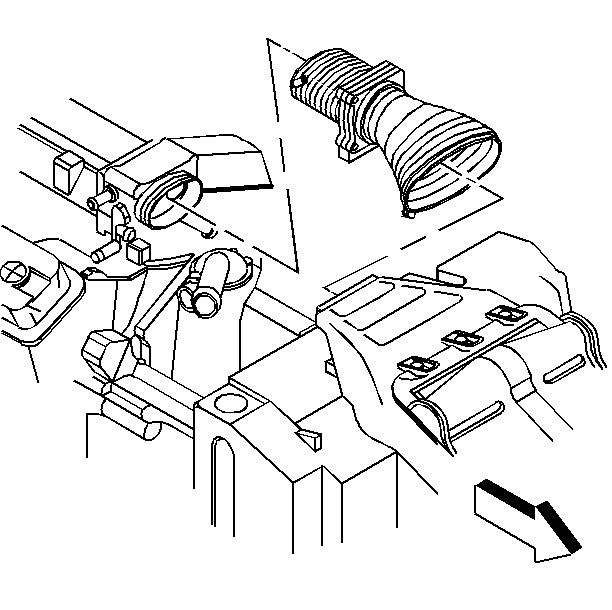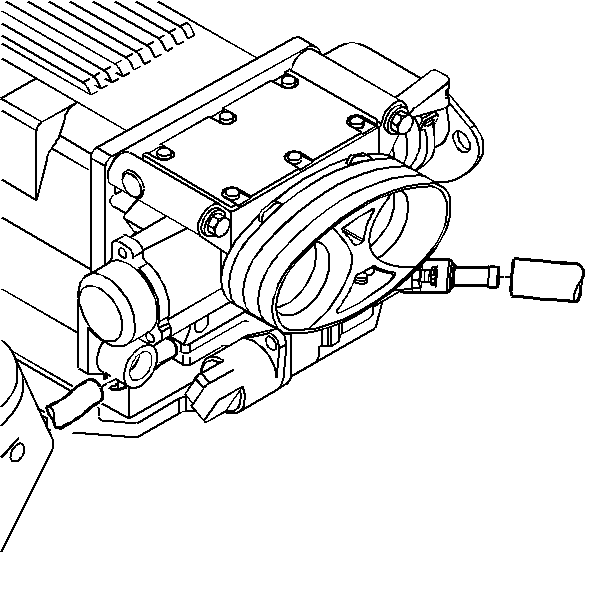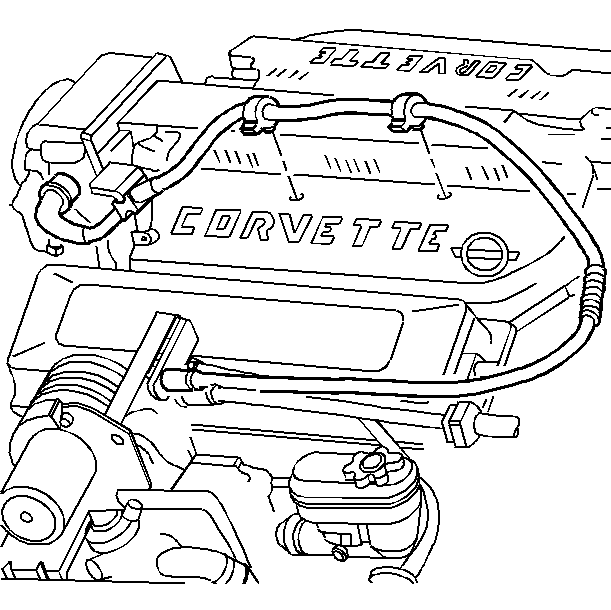Removal Procedure
- Disconnect the negative battery cable. Refer to
Caution: Unless directed otherwise, the ignition and start switch must be in the OFF or LOCK position, and all electrical loads must be OFF before servicing any electrical component. Disconnect the negative battery cable to prevent an electrical spark should a tool or equipment come in contact with an exposed electrical terminal. Failure to follow these precautions may result in personal injury and/or damage to the vehicle or its components.
in General Information. - Drain the cooling system. Refer to Cooling System Draining and Filling in Engine Cooling.
- Remove the air intake duct.
- Disconnect the electrical harness and the vacuum connection from the top of the engine.
- Disconnect the upper radiator hose from the water pump.
- Disconnect the throttle body coolant hose from radiator tee.
- Disconnect the lower radiator hose from the water pump.
- Disconnect the heater hose from the water pump.
- Disconnect the coolant hose from the right side of the throttle body.
- Remove the power steering pump. Refer to SECTION 3B.
- Remove the generator. Refer to Generator Replacement in Engine Electrical.
- Remove the left wheel well center panel.
- Remove the drive belt. Refer to Drive Belt Replacement .
- Remove the A/C compressor bolts and the compressor from the bracket and lay aside. Refer to SECTION 1B.
- Disconnect the electrical connector and the cover from the wiper motor.
- Remove the secondary air injection diverter valve hose.
- Disconnect the fuel lines from the fuel rails.
- Disconnect the hoses from the power steering fluid reservoir.
- Disconnect the accelerator cable from the throttle body.
- Raise and support the vehicle. Refer to SECTION 0A.
- Remove the starter motor. Refer to Starter Motor Replacement in Engine Electrical.
- Remove the left and right catalytic converters. Refer to Catalytic Converter Replacement in Engine Exhaust.
- Remove the exhaust pipe and the muffler. Refer to General Exhaust System Replacement in Engine Exhaust.
- Remove the transmission. For vehicles equipped with automatic transmissions, refer to Transmission Replacement in Automatic Transmission. For vehicles equipped with manual transmissions, refer to Transmission Removal in Manual Transmission.
- Remove the clutch cover and plate (manual transmission).
- Remove the flywheel. Refer to Engine Flywheel Replacement .
- Disconnect the ground leads from the rear of the engine.
- Disconnect the electrical connectors from the following assemblies:
- Remove the nuts from the engine mount studs. Refer to Engine Mount Replacement .
- Lower the vehicle.
- Install the engine lift hooks.
- Install the lift device.
- Remove the engine from the vehicle.



| 28.1. | The oil temperature sensor |
| 28.2. | The coolant temperature sensor |
| 28.3. | The knock sensor |
| 28.4. | The oil level sensor |
Installation Procedure
- Install the engine into the vehicle.
- Remove the lift device.
- Remove the engine lift hooks.
- Raise and support the vehicle.
- Install the nuts to the engine mount studs. Refer to Engine Mount Replacement .
- Connect the electrical connectors to the following assemblies:
- Connect the ground leads to the rear of the engine.
- Install the flywheel. Refer to Engine Flywheel Replacement .
- Install the clutch cover and plate (manual transmission).
- Install the transmission. For vehicles equipped with automatic transmissions, refer to Transmission Replacement in Automatic Transmission. For vehicles equipped with manual transmissions, refer to Transmission Installation in Manual Transmission.
- Install the left and right catalytic converters. Refer to Catalytic Converter Replacement in Engine Exhaust.
- Install the exhaust pipe and the muffler. Refer to General Exhaust System Replacement in Engine Exhaust.
- Install the starter motor. Refer to Starter Motor Replacement in Engine Electrical.
- Lower the vehicle.
- Connect the accelerator cable to the throttle body.
- Connect the hose to the power steering fluid reservoir.
- Connect the fuel lines to the fuel rail.
- Connect the secondary air injection diverter valve hose.
- Install the electrical connector and cover to the wiper motor.
- Install the A/C compressor to the bracket. Refer to SECTION 1B.
- Install the drive belt. Refer to Drive Belt Replacement .
- Install the left wheel well center panel.
- Install the generator. Refer to Generator Replacement in Engine Electrical.
- Install the power steering pump. Refer to SECTION 3B.
- Connect the coolant hose to the right side of the throttle body.
- Connect the heater hose to the water pump.
- Connect the lower radiator hose to the water pump.
- Connect the throttle body coolant hose to the radiator tee.
- Connect the upper radiator hose to the top of the water pump.
- Install the electrical harness and vacuum connectors to the top of the engine. The fuel injector electrical connectors are numbered by cylinder in order to match the connector to the correct fuel injector. If the connectors are not marked, refer to SECTION 8A for the proper wire colors to match the correct injectors.
- Install the secondary air injection intake duct.
- Connect the negative battery cable.
- Refill the cooling system. Refer to Cooling System Draining and Filling in Engine Cooling.
- Refill and bleed the power steering system. Refer to SECTION 3B.
- Reset the Change Oil Indicator. Refer to SECTION 8D.
- Adjust the TCS control cables. Refer to SECTION 5E2.
| 6.1. | The oil temperature sensor |
| 6.2. | The coolant temperature sensor |
| 6.3. | The knock sensor |
| 6.4. | The oil level sensor |


Tighten
Tighten the negative battery cable bolt to 15 N·m (11 lb ft).
Notice: Use the correct fastener in the correct location. Replacement fasteners must be the correct part number for that application. Fasteners requiring replacement or fasteners requiring the use of thread locking compound or sealant are identified in the service procedure. Do not use paints, lubricants, or corrosion inhibitors on fasteners or fastener joint surfaces unless specified. These coatings affect fastener torque and joint clamping force and may damage the fastener. Use the correct tightening sequence and specifications when installing fasteners in order to avoid damage to parts and systems.
